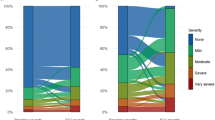Summary
l-Asparaginase treatment of leukemia patients causes hemostatic problems. To investigate whetherl-asparaginase influences coagulation studies, 63 blood samples of 21 healthy male donors were incubated withl-asparaginase for 30 min at room temperature. After treatment with 100 IU/mll-asparaginase plasma fibrinogen (P=0.002), plasma antithrombin (P=0.0002), plasma protein C (P=0.0004), and plasma plasminogen (P=0.0039) were decreased compared with controls. In contrast, a significant increase in plasma von Willebrand factor antigen (P=0.08) and plasma thromboglobulin (P=0.005) was observed. The decrease in plasma antithrombin (P=0.001), plasma protein C (P=0.0003), and plasma plasminogen (P=0.0043) was also measurable after 0.05 IU/ml asparaginase treatment. The incubation withl-asparaginase was similar to the normal time from blood sampling to testing and hence the results suggest thatl-asparaginase may directly attack proteins of the coagulation system during the interval between sampling and assay.
Similar content being viewed by others
References
Haskell CM, Canellos GP, Leventhal BG, Carbone PP, Block JB, Serpick AA, Selawryl OS.l-Asparaginase. Therapeutic and toxic effects in patients with neoplastic disease. N Engl J Med 1969: 281:1028.
Capizzi, R., Holcenberg JS.l-Asparaginase. In: Holland J, Frei E. (eds.) Cancer medicine, Philadelphia: Lea and Febiger: 1992.
Andrew M, Brooker L, Mitchell L. Acquired antithrombin III deficiency secondary to asparaginase therapy in childhood acute lymphoblastic leukemia. Blood Coagulation and Fibrinolysis 1994; 5:24.
Mitchell L, Hoogendoorn H., Giles AR, Vegh P., Andrew M. Increased endogenous thrombin generation in children with acute lymphoblastic leukemia: risk of thrombotic complications inl-asparatinase-induced antithrombin III deficiency. Blood 1994; 83:386
Nowak-Göttl U, Wolff J, Kuhn N, Boos J, Kehrel B, Lilienweiß V., Schwabe D, Jürgens H.: Enhanced thrombin generation. P-von Willebrand factor. P-Fibrin D-dimer and P-Plasminogen activator inhibitor 1: predictive for venous thrombosis in asparaginase-treated children. Fibrinolysis 1994; 8:63.
Rossi EP, Montonico P, Lombardi A, Preda L. Method for the determination of functional (clottable) fibrinogen by the new family of ACL coagulometers. Thromb Res 1988: 52:453.
Clauss A. Gerinnugsphysiologische Schnellmethode zur Bestimmung des Fibrinogens. Acta Haematol (Basel) 1957; 17:237.
Odegard OR, Lie M, Abildgaard U. Heparin cofactor activity measured with an amidolytic method. Thromb Res 1975; 6:287.
Martinoli JL, Stocker K. Fast functional protein C assay using protac, a novel protein C activator. Thromb Res. 1986; 43:253.
Preda L, Tripodi A, Valsecchi C, Lomardi A, Finotto E, Mannucci PM. A prothrombin time based functional assay of protein S. Thomb Res 1990; 60:19.
Fribeger P. Chromogenic peptide substrates. Their use for the assay of factors in the fibrinolytic and plasma kallikrein-kinin systems. Scand J Clin Lab Invest. 1982: 42:49.
Blombäck M, Abildgaard U, Besselaar van den, et al., Nomenclature of quantities and units in thrombosis and haemostasis (recommendation 1993). Thromb Haemost 1994; 71: 375.
McCornach RL. Extended tables of the Wilcoxon matched pair signed rank statistic. J Am Statist Assoc 1965; 60: 864.
Bergemeyer HU. Methoden der enzymatischen Analyse. L-Asparaginase. 3. überarb. und erw. Auflage. Weinheim: Verlag Chemie: 1974: p. 464.
Nowak-Göttl U, Boos J, Werber G. Ahlke E. Jürgens H. Dependence of asparaginase-induced coagulopathy on serum asparaginase activity: a randomized trial. Haematology and Blood transfusion. In press.
Holland JF Ohnuma T and cancer and leukemic group B investigators. Cancer Treat Rep 1981: 65:123.
Eckhof-Donovan S, Schwamborn D, Michelmann I, Kries R v., Nürnberger W, Göbel U. Thrombosis in children with acute lymphoblastic leukemia treated with the COALL-protocol. Klin Pädiatr 1994; 206:327.
Kinglough-Rathbone RL, Packham MA, Reimers HJ, Cazenave JP, Mustard JF: Mechanism of platelet shape change, aggregation and release induced by collagen, thrombin or A 23187. J Lab Clin Med 1977; 90:707.
Author information
Authors and Affiliations
Rights and permissions
About this article
Cite this article
Nowak-Göttl, U., Boos, J., Wolff, J.E.A. et al. Asparaginase decreases clotting factors in vitro: a possible pitfall?. Int J Clin Lab Res 25, 146–148 (1995). https://doi.org/10.1007/BF02592556
Received:
Accepted:
Issue Date:
DOI: https://doi.org/10.1007/BF02592556




